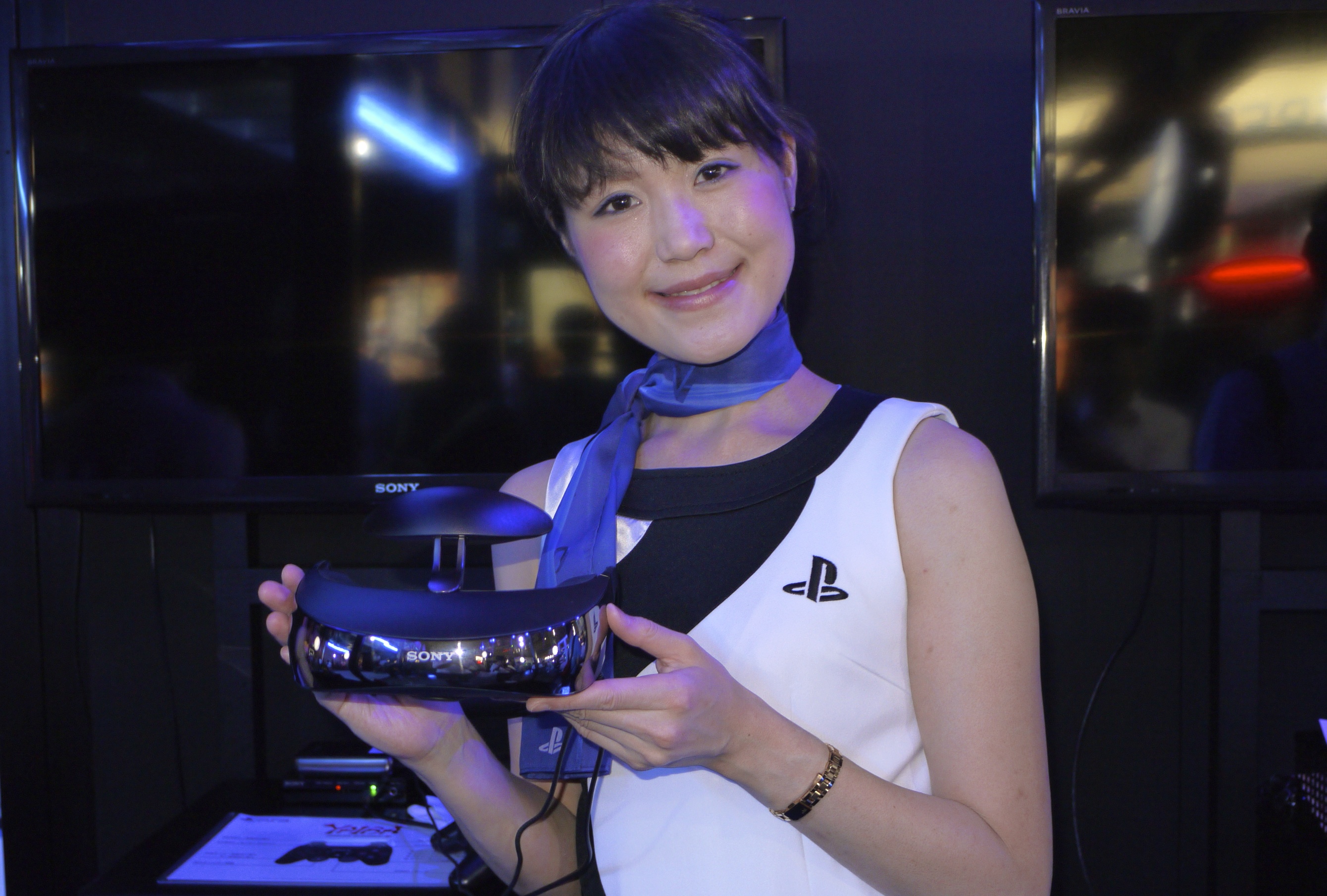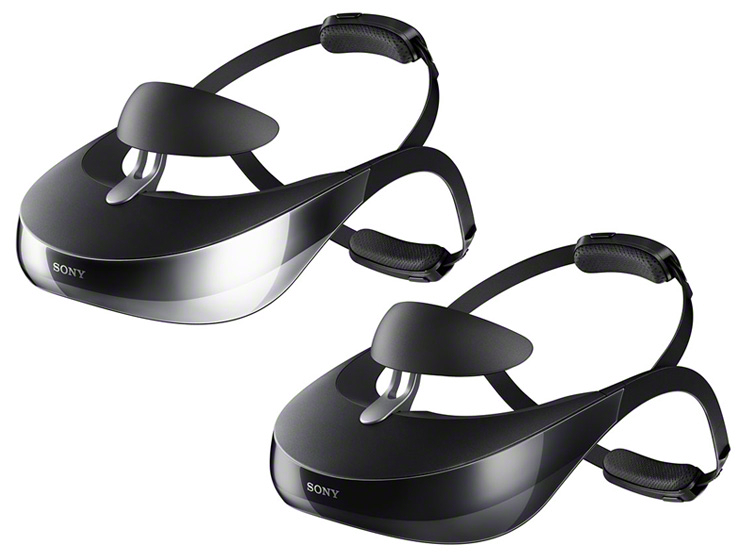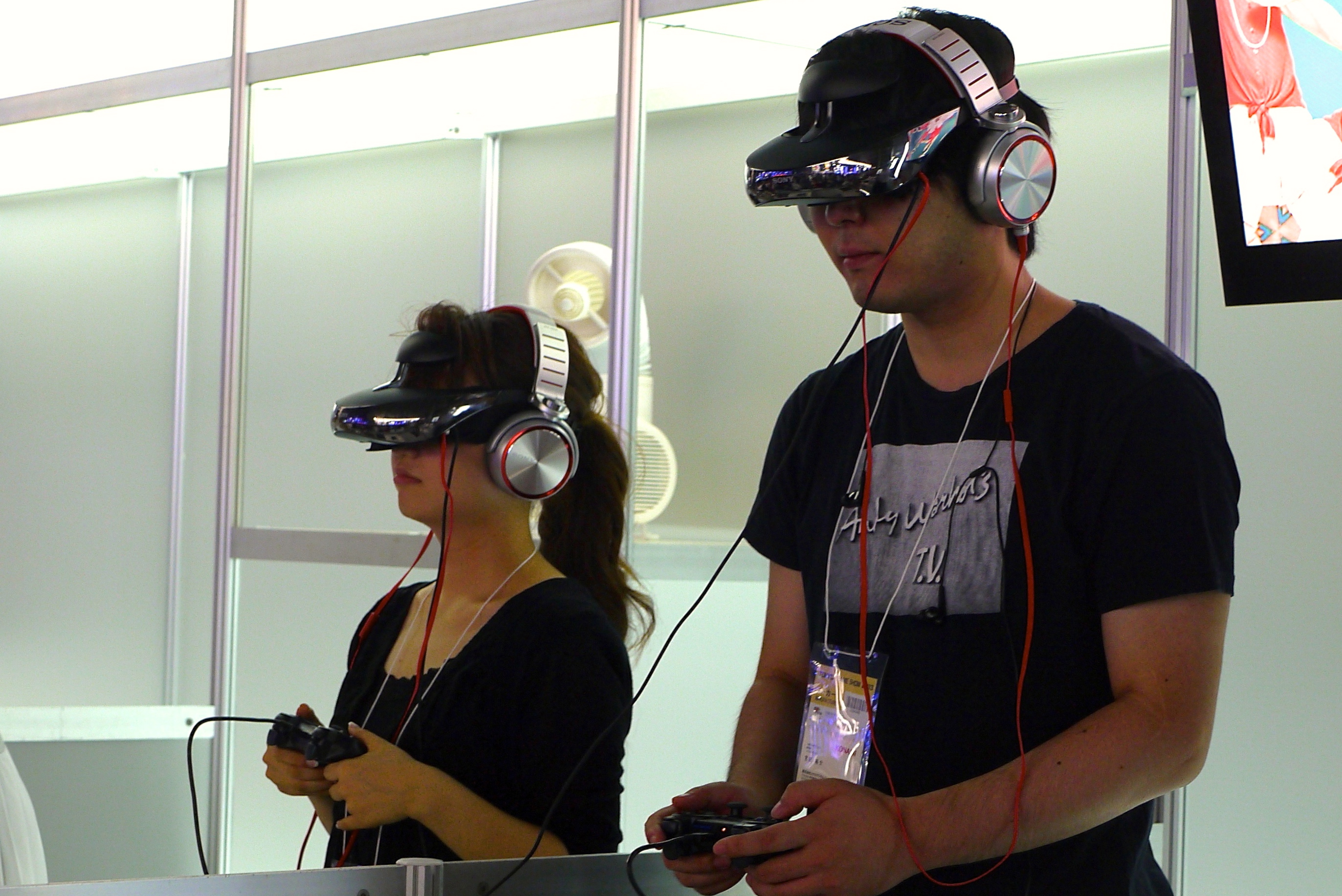
As well as showing off its new PlayStation 4 console, PlayStation Vita 2000 handheld and Xperia Z1 smartphone at last week’s Tokyo Game Show, electronics giant Sony was also quietly pushing its newly designed HMZ-T3 personal viewer headset into tech fans’ consciousness, with demo units popping up in a number of booths. Since bringing its first headset to the market back in 2011, Sony has been gradually tweaking and refining its tech in response to consumer feedback, with its newest iteration due to go on sale later this year.
With the HMZ-T3, Sony has produced its lightest, most compact headset yet, retaining the ability to watch movies and play video games in both 2-D and stereoscopic 3-D, as well as boasting smartphone connectivity and, for the first time, wireless operation thanks to a portable battery pack.
Our experience of the previous model having been something of a bittersweet affair, we were keen to see whether Sony had managed to perfect its headset the third time around, so with the help of a friendly booth attendant we slipped on the new HMZ-T3 and put it through its paces.
Despite looking rather like the virtual reality visors many of us grew up dreaming we’d all be wearing in the future, Sony’s HMZ range of headsets are in fact “personal viewers” whose images remain in front of the wearer’s eyes regardless of their head movements. Even so, the moment we had the futuristic-looking HMZ-T3 in our hands we couldn’t help feeling a tingle of excitement.
▼ The HMZ-T3W and HMZ-T3
As with previous models, the HMZ-T3 requires a little adjusting before it sits comfortably over the user’s eyes, with two straps that go around the back of the wearer’s head, a supporting forehead pad (which is noticeably larger than those of previous iterations in order to spread the unit’s weight over a larger surface area and avoid leaving pink imprints), and a nose groove akin to that of a diving mask.
The majority of the unit’s weight is supported by the rear head straps, though those with slightly larger sniffers will undoubtedly feel a little pressure on the bridge of the nose from the moment the unit it slipped on. The rear headband can be adjusted to pull the unit closer to the wearer’s face, and the twin 720p OLED displays can be shifted a few centimetres left and right in order to comfortably create a single image. The unit can also be used while wearing glasses, though smaller frames will of course work better than chunky, hipster specs.
Although the majority of the demo units at TGS were at Sony’s Xperia smartphone booth in order to flaunt the hardware’s interconnectivity and the headset’s use as a movie viewer, the one I was trying out was connected to a PlayStation 3 console running Yaiba: Ninja Gaiden Z, a stylish, third-person combat game due for release in 2014. After the booth attendant had left me to my own devices (at least I think she had – although the HMZ is open at the bottom allowing the wearer to see a little of the world around them and avoid feelings of claustrophobia, being unable to see much of the room around you while playing is an unusual sensation), I set to hacking and slashing, doing my best to forget the unit strapped to my head and focus on the experience itself, which is undoubtedly Sony’s main goal in designing the personal viewer.
At first, the image before my eyes was not entirely clear and I found the on-screen text difficult to focus on, but with a little wiggling and a quick head-strap adjustment, I was able to find my own sweet-spot and everything suddenly snapped into place. Just as with the HMZ-T2, the new headset certainly does not fail to impress; despite the image being created by two small displays just a couple of inches before your eyes, the brain is tricked into thinking it is looking at one enormous screen, meaning that even those who live in cramped Tokyo apartments can watch movies and play games as if they were running on a home cinema display. Black edges are visible around the edge of the image at all times – as they are when looking at a movie screen or TV unless you happen to be sitting dangerously close, of course – but once you focus on the movie or game itself they soon disappear from consciousness.
Telling the story of a cyborg ninja out for revenge, it probably goes without saying that Yaiba: Ninja Gaiden Z features more blades and blood splashes than a Tarantino movie set in a butcher’s shop, and if I’m being completely honest games of its kind are not usually my cup of tea, but I was surprised at how quickly I became caught up in the action while wearing the headset, and on more than one occasion actually found myself dodging slightly when enemies lunged in my character’s direction. It may take a little getting used to, but the HMZ-T3 offers an incredibly sharp and immersive visual experience, make no mistake.
Weighing in at 320 grams, the HMZ-T3 is only 10 grams lighter than its predecessor (itself a vast improvement on the original’s whopping 420 grams), but feels much lighter thanks to its larger forehead pad and more supportive rear head straps. Even so, after around 10 minutes of use, the weight of the unit on the bridge of the nose did start to become noticeable, not to mention the forehead pad a little clammy. We were standing for the entire duration of our test run, which is hardly the most relaxing position for gaming or watching a movie, so perhaps with a comfy chair to recline in this may be less of an issue, however.
As well as providing the option to reduce the size of the visible image by up to 30 percent (something that gamers may wish to do as, during my own hands-on, I missed a couple of on-screen prompts purely because they appeared outside of my main field of vision) the new headset is designed with connectivity to Android smartphones – particularly Sony’s own Xperia – in mind, offering both wireless and micro-HDMI connectivity and even 7.1 channel sound. In order to watch those movies on-the-go with your smartphone, however, you’ll be needing to pick up the wireless HMZ-T3W, which comes with a small external battery pack that allows up to three hours of video HD playback.
For all of its improvements and the astounding sense of immersion the HMZ-T3 creates, however, we cannot recommend picking one up at this point in time. Gamers and movie lovers would no doubt love to add this headset to their hardware collection, but with the HMZ-T3W set to retail for around 100,000 yen (US$1,000) when it launches in Japan in mid-November, and a massive £1,300 (US$2,080) in the UK, we can’t help wondering exactly who the product is intended for, especially considering that the consoles and smartphones Sony suggests hooking the unit up to retail for roughly half the price.
Nevertheless, it is admirable to see Sony pushing ahead with this technology. Despite slow sales and obvious flaws in earlier iterations, the company is slowly but surely refining its hardware and coming ever closer to producing a must-have gadget for hardcore gamers and movie lovers everywhere. Telling a company to come back and try again next year is usually intended as a slight, but we’re genuinely excited to see where Sony is going with its line of headsets. With a few more adjustments, and perhaps a smaller price tag, we could definitely see ourselves geeking out with an HMZ in a couple of years.
Photos: RocketNews24 Product image: Sony



 Newsflash: Sony unveils “Project Morpheus”, new virtual reality headset for PlayStation 4
Newsflash: Sony unveils “Project Morpheus”, new virtual reality headset for PlayStation 4 Sony’s new Xperia Z3 compact tablet boasts PlayStation 4 remote play, controller mount
Sony’s new Xperia Z3 compact tablet boasts PlayStation 4 remote play, controller mount Oculus Rift vs Project Morpheus: The VR headsets duke it out at E3【RN24@E3】
Oculus Rift vs Project Morpheus: The VR headsets duke it out at E3【RN24@E3】 REVIEW: Sony’s new tablet is thinner and lighter than the iPad Air, and Android fans will love it
REVIEW: Sony’s new tablet is thinner and lighter than the iPad Air, and Android fans will love it The new PlayStation VR comes with an adorable miniature PlayStation 4
The new PlayStation VR comes with an adorable miniature PlayStation 4 Japanese ramen restaurants under pressure from new yen banknotes
Japanese ramen restaurants under pressure from new yen banknotes New private rooms on Tokaido Shinkansen change the way we travel from Tokyo to Kyoto
New private rooms on Tokaido Shinkansen change the way we travel from Tokyo to Kyoto McDonald’s new Happy Meals offer up cute and practical Sanrio lifestyle goods
McDonald’s new Happy Meals offer up cute and practical Sanrio lifestyle goods French Fries Bread in Tokyo’s Shibuya becomes a hit on social media
French Fries Bread in Tokyo’s Shibuya becomes a hit on social media Japanese company starts project to restore Nakagin Capsules to capsule hotel
Japanese company starts project to restore Nakagin Capsules to capsule hotel We tried Korea’s way-too-big King Tonkatsu Burger at Lotteria 【Taste Test】
We tried Korea’s way-too-big King Tonkatsu Burger at Lotteria 【Taste Test】 Studio Ghibli releases new action figures featuring Nausicaä of the Valley of the Wind characters
Studio Ghibli releases new action figures featuring Nausicaä of the Valley of the Wind characters Secret Kitchen bento serves Japanese flowers, birds, wind and moon in a box, but is it worth it?
Secret Kitchen bento serves Japanese flowers, birds, wind and moon in a box, but is it worth it? Sakura tree falls on man at Sannenzaka near Kiyomizu temple in Kyoto 【Breaking News】
Sakura tree falls on man at Sannenzaka near Kiyomizu temple in Kyoto 【Breaking News】 Cosplay in front of explosions and flames at the upcoming fiery Baku Festival
Cosplay in front of explosions and flames at the upcoming fiery Baku Festival All-you-can-drink Starbucks and amazing views part of Tokyo’s new 170 meter-high sky lounge
All-you-can-drink Starbucks and amazing views part of Tokyo’s new 170 meter-high sky lounge More foreign tourists than ever before in history visited Japan last month
More foreign tourists than ever before in history visited Japan last month Starbucks reopens at Shibuya Scramble Crossing with new look and design concept
Starbucks reopens at Shibuya Scramble Crossing with new look and design concept Disney princesses get official manga makeovers for Manga Princess Cafe opening in Tokyo
Disney princesses get official manga makeovers for Manga Princess Cafe opening in Tokyo Beautiful new Final Fantasy T-shirt collection on the way from Uniqlo【Photos】
Beautiful new Final Fantasy T-shirt collection on the way from Uniqlo【Photos】 Is the new Shinkansen Train Desk ticket worth it?
Is the new Shinkansen Train Desk ticket worth it? Studio Ghibli glasses cases let anime characters keep an eye on your spectacles
Studio Ghibli glasses cases let anime characters keep an eye on your spectacles Studio Ghibli releases Kiki’s Delivery Service chocolate cake pouches in Japan
Studio Ghibli releases Kiki’s Delivery Service chocolate cake pouches in Japan New definition of “Japanese whiskey” goes into effect to prevent fakes from fooling overseas buyers
New definition of “Japanese whiskey” goes into effect to prevent fakes from fooling overseas buyers Our Japanese reporter visits Costco in the U.S., finds super American and very Japanese things
Our Japanese reporter visits Costco in the U.S., finds super American and very Japanese things Studio Ghibli unveils Mother’s Day gift set that captures the love in My Neighbour Totoro
Studio Ghibli unveils Mother’s Day gift set that captures the love in My Neighbour Totoro Domino’s Japan now sells…pizza ears?
Domino’s Japan now sells…pizza ears? New Japanese KitKat flavour stars Sanrio characters, including Hello Kitty
New Japanese KitKat flavour stars Sanrio characters, including Hello Kitty New Pokémon cakes let you eat your way through Pikachu and all the Eevee evolutions
New Pokémon cakes let you eat your way through Pikachu and all the Eevee evolutions Sales of Japan’s most convenient train ticket/shopping payment cards suspended indefinitely
Sales of Japan’s most convenient train ticket/shopping payment cards suspended indefinitely Sold-out Studio Ghibli desktop humidifiers are back so Totoro can help you through the dry season
Sold-out Studio Ghibli desktop humidifiers are back so Totoro can help you through the dry season Japanese government to make first change to romanization spelling rules since the 1950s
Japanese government to make first change to romanization spelling rules since the 1950s Ghibli founders Toshio Suzuki and Hayao Miyazaki contribute to Japanese whisky Totoro label design
Ghibli founders Toshio Suzuki and Hayao Miyazaki contribute to Japanese whisky Totoro label design Doraemon found buried at sea as scene from 1993 anime becomes real life【Photos】
Doraemon found buried at sea as scene from 1993 anime becomes real life【Photos】 Tokyo’s most famous Starbucks is closed
Tokyo’s most famous Starbucks is closed One Piece characters’ nationalities revealed, but fans have mixed opinions
One Piece characters’ nationalities revealed, but fans have mixed opinions We asked a Uniqlo employee what four things we should buy and their suggestions didn’t disappoint
We asked a Uniqlo employee what four things we should buy and their suggestions didn’t disappoint Princesses, fruits, and blacksmiths: Study reveals the 30 most unusual family names in Japan
Princesses, fruits, and blacksmiths: Study reveals the 30 most unusual family names in Japan Sony set to make “aggressive” move into AR phone gaming market thanks to success of Pokémon GO
Sony set to make “aggressive” move into AR phone gaming market thanks to success of Pokémon GO Sony really, really wants you to buy an Xperia smartphone 【Tokyo Game Show】
Sony really, really wants you to buy an Xperia smartphone 【Tokyo Game Show】 Countdown to PlayStation 4 in Japan – Mr. Sato heads to the Sony Building to join the fun
Countdown to PlayStation 4 in Japan – Mr. Sato heads to the Sony Building to join the fun Sony’s wearable air conditioners selling like cold cakes in heat-stricken Japan
Sony’s wearable air conditioners selling like cold cakes in heat-stricken Japan Is the Nintendo Switch a viable VR platform?【Video】
Is the Nintendo Switch a viable VR platform?【Video】 Sony gives PlayStation 3 game cases a facelift, netizens complain they can’t tell games apart
Sony gives PlayStation 3 game cases a facelift, netizens complain they can’t tell games apart Sony unveils bizarre new TV remote control with built-in speaker, met with confusion and LOLs
Sony unveils bizarre new TV remote control with built-in speaker, met with confusion and LOLs Is boob-shaped controller a clever gag ad, pie in the sky dream, or the future of gaming? 【Video】
Is boob-shaped controller a clever gag ad, pie in the sky dream, or the future of gaming? 【Video】 Sony’s summer PlayStation Vita ads are all about growing up【Video】
Sony’s summer PlayStation Vita ads are all about growing up【Video】 So long, PlayStation 4 – Sony announces it’s ending repair service for early PS4 models
So long, PlayStation 4 – Sony announces it’s ending repair service for early PS4 models Move over headphones, Sony’s new speakers let you blast music out of your shoulders
Move over headphones, Sony’s new speakers let you blast music out of your shoulders Tekken producer explains virtual reality girl demo ‘Summer Lesson’
Tekken producer explains virtual reality girl demo ‘Summer Lesson’ PlayStation 3 gets a price cut in Japan, still costs more than it probably ought to
PlayStation 3 gets a price cut in Japan, still costs more than it probably ought to No console? No problem! Sony tests streaming video games direct to TV sets
No console? No problem! Sony tests streaming video games direct to TV sets Japanese ‘Day One Edition’ Xbox One adopters are actually getting a pretty good deal
Japanese ‘Day One Edition’ Xbox One adopters are actually getting a pretty good deal Sony developing audio player that delivers music to you without putting a device in your ear
Sony developing audio player that delivers music to you without putting a device in your ear
Leave a Reply